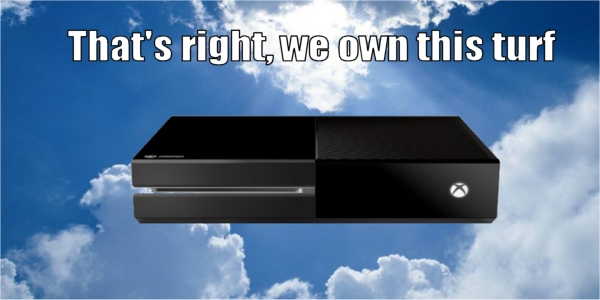Microsoft Demonstrates The Power Of Cloud For Xbox One

During the Build 2014 conference there was a live stage demonstration that Microsoft put on demonstrating “the power of the cloud” for their Azure network services. Yes, the same services that power the Xbox One's cloud infrastructure. The video showcases a demonstration of a building being demolished on a high-end PC and a building being demolished via the cloud, and the demonstration purportedly puts across the point that a high-end PC can't quite hang with the power of the cloud. Right.
DualShockers spotted the video from YouTube user Arekkz Gaming, in which the video details just how much more powerful processing is, cloud-side. Microsoft's John Shewchuk stated...
“ What we really think is that the power of the cloud enables new kinds of experiences that have never been possible. Even if we had multiple high end machines, they couldn’t do the kind of bandwidth that we’re doing.“What’s happening is the computation are going on in the cloud, we’re sending those rotations and the positional information down to the clients where the rendering is getting done.”
The thing is, I can't get over the video. Check it out below.
People who actually know that “cloud” is just a buzzword for server-side calculations aren't fooled by the wool Microsoft is trying to pull over the eyes of the uninformed.
Many users made the very adept observation that the physics demo running on “high-end PCs” is never properly detailed. What kind of high-end PC? What GPU? What's the CPU setup? Is the demo running on software or hardware? Are APIs handling any of the load or is it coded to the metal? Is this a high-end PC from 2014? 2013? 2012? 2011? 2010? 1999? Is it running a Voodoo AGP card? What's the stats? Nothing?
I call shenanigans.
Now before I get to the next point, I would just like to point out that in the video, the repeated use of “high-end PC” in comparison to the cloud demonstration seemed like a subtle marketing dig to say “Oh hey, those high-end PCs we were caught using at E3 don't compare to the power of the cloud for the Xbox One”.
Your Daily Blend of Entertainment News
But getting back on point: The reason I call shenanigans is because this video from 2010 shows Nvidia's CUDA cores at work where a lot more than 30,000 particle chunks are on the screen. Check it out below.
So why is hardware from 2010 more capable than stage presentation hardware from 2014? What's going on here?
Oh, but we're not done yet.
Nvidia was also powering through tens of thousands of individual real-time particles on a single GTX 580 to showcase the optimization of their particle simulation technology, and the GTX 580 isn't even their most powerful GPU.
Furthermore, Shewchuk talks about how the “high-end PC” slows to a crawl processing those 32,045 particle chunks in the simulation at the top of the article. If the video featuring Nvidia's Fermi tech didn't quite give you an understanding of how misrepresentative Microsoft's cloud demo is, check out the video below. It's a real-time active particle simulation consisting of 100,000 individual units running in the Unreal Development Kit by Epic Games... on a client-side machine... a machine from 2011!
As I said... shenanigans.
A GTX Titan would have destroyed that Build 2014 destruction demo at the top of the article... easily.
Even more than that, this is a very false representation of cloud capabilities, given that many gamers brought out a very poignant point: If you're playing a game like Halo 5 on launch day and the Azure servers are handling physics calculations server-side, what happens when you have a million or so gamers all trying to play the game at once? Will the 300,000 servers be able to handle simultaneous, physics-heavy calculations for every single player? It's a rhetorical question but I'm sure a fanboy or two will come up with an answer.
Even still, I would point to Titanfall's less-than-smooth launch with its servers, as reported by NowGamer, as a prime indicator that the Azure isn't ready to handle anything more than the typical server-heavy fanfare that multiplayer games have been using utilizing throughout seventh-gen gaming.

Anyway, take note that Microsoft will probably keep trying to sell the misinformed (or uninformed) masses on “the power of the cloud”. I get a bad feeling that the Doritocracy will be averse to actually informing the public at large about what the real limitations and capabilities of server-side calculations entail (e.g., Diablo III, Simcity), which means we could be in for an interesting marketing run by Microsoft throughout the Xbox One's lifespan, especially when you have articles about "the power of the cloud" on sites like Game Informer that could mislead the public on what the functions of the cloud really means in real-world simulations.
And just for good measure, feel free to check out this video of Nvidia's Titan running a real-time ocean simulation that has a heck of a lot more individual calculations happening on-screen compared to that silly building destruction demo at the top.
Staff Writer at CinemaBlend.

